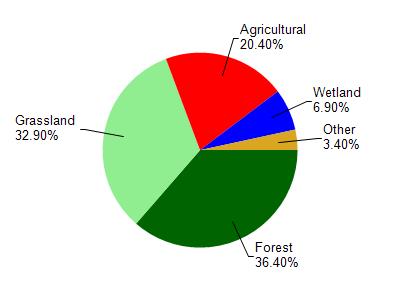Richland, Sauk
No
No
No
Fish and Aquatic Life
Overview
Cazenovia Branch is a spring and seepage fed tributary to the Little Baraboo River. The stream has been impounded to form Lee Lake in the village of Cazenovia. The lower 2.5 miles of the creek are considered a warm water forage fishery. Another 4.6 miles are considered a Class II trout stream. The stream has some potential to be a Class I trout stream, however, it has some problems with nonpoint sources of pollution. In addition, portions of the creek have been straightened in an attempt to reduce streambank erosion.
Monitoring conducted in 1999 found good water quality as evidenced by the fish species found. A cursory habitat evaluation was conducted during the summer of 2001. The evaluation found the creek to have mostly good quality habitat below Lee Lake, but poor quality above the lake. The main habitat problem above the lake can be attributed to heavy sedimentation and a lack of exposed stream bottom. The habitat further upstream from the lake, however, appeared to be of better quality than that directly above the lake. The most prominent problem is from nonpoint sources of pollution from the surrounding watershed and bank failure and erosion.
Date 2002
Author Cynthia Koperski
General Condition
Cazenovia Branch (WBIC 1283100) from the Sauk-Richland county line to the headwaters was assessed during the 2018 listing cycle; new biological (fish Index of Biotic Integrity (IBI) scores) sample data were clearly below the 2018 WisCALM listing thresholds for the Fish and Aquatic Life use. This water was meeting this designated use and was not considered impaired.
Date 2017
Author Ashley Beranek
Impaired Waters
Cazenovia Branch (1283100) from its mouth to Carr Valley Creek was placed on the impaired waters list for total phosphorus in 2014. The 2016 assessments showed continued impairment by phosphorus; total phosphorus sample data exceed 2016 WisCALM listing criteria for the Fish and Aquatic Life use, however, no biological data (i.e. no macroinvertebrate or fish Index of Biotic Integrity (IBI) scores) were available to assess biological impairment. Based on the most updated information, no change in existing impaired waters listing is needed.
Date 2015
Author Aaron Larson
Condition
Wisconsin has over 84,000 miles of streams, 15,000 lakes and milllions of acres of wetlands. Assessing the condition of this vast amount of water is challenging. The state's water monitoring program uses a media-based, cross-program approach to analyze water condition. An updated monitoring strategy (2015-2020) is now available. Compliance with Clean Water Act fishable, swimmable standards are located in the Executive Summary of Water Condition in 2018. See also the 'monitoring and projects' tab.
Reports
Management Goals
Wisconsin's Water Quality Standards provide qualitative and quantitative goals for waters that are protective of Fishable, Swimmable conditions [Learn more]. Waters that do not meet water quality standards are considered impaired and restoration actions are planned and carried out until the water is once again fishable and swimmable
Management goals can include creation or implementation of a Total Maximum Daily Load analysis, a Nine Key Element Plan, or other restoration work, education and outreach and more. If specific recommendations exist for this water, they will be displayed below online.
Monitoring
Monitoring the condition of a river, stream, or lake includes gathering physical, chemical, biological, and habitat data. Comprehensive studies often gather all these parameters in great detail, while lighter assessment events will involve sampling physical, chemical and biological data such as macroinvertebrates. Aquatic macroinvertebrates and fish communities integrate watershed or catchment condition, providing great insight into overall ecosystem health. Chemical and habitat parameters tell researchers more about human induced problems including contaminated runoff, point source dischargers, or habitat issues that foster or limit the potential of aquatic communities to thrive in a given area. Wisconsin's Water Monitoring Strategy was recenty updated.
Grants and Management Projects
Monitoring Projects
| WBIC | Official Waterbody Name | Station ID | Station Name | Earliest Fieldwork Date | Latest Fieldwork Date | View Station | View Data |
|---|
| 1283100 | Cazenovia Br | 10021682 | Cazenovia Br. 300 m us from mouth of Carr Valley Creek | 5/17/2012 | 10/22/2015 | Map | Data |
|

Watershed Characteristics
Cazenovia Br is located in the Crossman Creek and Little Baraboo River watershed which is 213.80 mi². Land use in the watershed is primarily forest (36.40%), grassland (32.90%) and a mix of agricultural (20.40%) and other uses (10.30%). This watershed has 466.61 stream miles, 244.11 lake acres and 6,321.59 wetland acres.
Nonpoint Source Characteristics
This watershed is ranked Not Available for runoff impacts on streams, Not Available for runoff impacts on lakes and High for runoff impacts on groundwater and therefore has an overall rank of High. This value can be used in ranking the watershed or individual waterbodies for grant funding under state and county programs.However, all waters are affected by diffuse pollutant sources regardless of initial water quality. Applications for specific runoff projects under state or county grant programs may be pursued. For more information, go to surface water program grants.